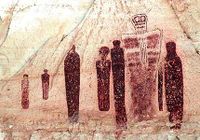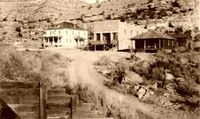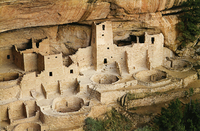Sego Canyon Cave Paintings
By Devon Washington

Sego Canyon Cave paintings are a group of hundreds of seeemingly human figures suggested to depict ancient astronauts or extraterrestrials that once visited the Earth when the multiple Native American tribes lived in this area. Multiple type of rock art can be seen from multiple tribes that lived and passed through these lands.
Background
History of Sego
Sego Utah started off in the early 1890s as farmer Harry Ballard discovered coal on the lands next to his ranch. He then began purchasing this land to begin small scale coal mining operations that eventually rose to a small community named Ballard, after the owner.

Ballard’s property was eventually bought out and the American Fuel Company began to develop the area in 1911 with plans for long-term coal production. Over time the company was plagued with water system problems, low profits, power supply issues and overall financial problems. At some points, there was no money to pay the miners, they were given scripts to spend at the company store.The miners soon reorganized in 1933 under the United Mine Workers to finally secure regular pay. Then in 1947 the mine was ordered closed and the remaining 27 miners bought the property.
In 1949 a fire swept the site. This drastically decreased productions. When diesel engines mostly replaced coal powered steam engines, the company came to a halt. After this, the shareholders sold all their stakes in this land to a company from Texas whose main interest in the land was more for natural gas and oil. Sego then became a ghost town after its final revenge by treasure hunters in 1973.[2]
Fremont Tribe
From approximately 600-1250 A.D. the Sego Canyon was occupied by the Fremont Native Tribe. Named after the Fremont river and valley were most of their site were discovered, the Fremont tribe was one closely tied to nature with their hunting, gathering, and farming lifestyle. They lived in pit houses, created pottery and rock art that is distinguishable by the rectangular or trapezoidal bodies and small heads.[1] They are quite different as their lifestyle is more sedentary than that of most other tribes. The Fremont tribe culture has all but disappeared and many changes that occured are to blame. Due to the climate, farming conditions had changed dramatically forcing groups to forage for food from the land and, as new settlers migrated the Fremont tribe slowly vanished.[3]
Barrier Canyon
The Barrier Canyon rock art was created by the Archaic people around 6000 B.C.-100 B.C. consisting of large manlike forms. Often these forms were missing legs or arms, had hollowed eyes, wore antennae-like earrings, and carried snakes. Figures like these may depict the ritualistic activities that took place amongst these people.[1] Mainly, the Barrier Canyon style was composed of three type of figures: the spirit figure, the citizen figure, and the composite figure. The spirit figure is often the figure depicted with no arms or legs and large oversized eyes. Occasionally they also had horns or antennae with a 'water/life-giving symbol' torso, meaning they were often drawn with parallel lines, lines of dots, zig zag lines, and snake images. The spirit images were also some of the tallest figures, with one estimated at around nine feet![4] The citizen figures are rather small in comparison, usually no more than six inches in active postures. The composite figures were not represented as much but tended to be a combination of animal parts. They varied from snake bodies with sheep heads and bird's feet, sheep torsos with canine heads and human arms and so on.[4]
Ute Tribe
From approximately 1300 A.D. to 1880 A.D. the Ute Native tribe occupied the Sego Canyon area until they were forced to live on reservations in 1880. The Ute tribe rock art can be identified by the horse riding figures, as horses weren’t introduced until the 16th century by the Spanish.[1] The Mormon settlers also introduced agriculture which changed their way of life. Some areas of the tribe rejected farming, opposing settling down in one place. Today the Ute people are a have diverse income resources and their own government.[5]
Religion
Although the Ute tribe did not have a formal religion they believed that there was power and knowledge to be obtained from dreams, visions, or mythical beings. They often depicted animals, especially wolves, in their artwork as having human-like forms or traits. They also believed in the power Shamans held to heal through their dreams. Their dreams would show them visions and the treatments were through dance, song or paraphernalia. [6]
Anasazi Tribe
The Anasazi tribe occupied the land as early as 1500 B.C. building villages from mud and stone and miles of road. They scaled the cliffs to build some of the magnificent structures, some 5 stories high. As many as 30,000 lived there at one time creating the petroglyphs and beautiful pottery.The Anasazi tribe has survived a great deal. These events ranged from warfare that caused some cannibalistic periods to assaults from spanish colonizers. Still the Anasazi tribe has survived one generation after the next. Today they are the ancestors of the Taos Pueblo in New Mexico and the Hopi villages in Arizona.[7] The period from 1200 B.C. – A.D. 50 is known as the Basketmaker I culture. The term is derived from the fact that these people wove baskets, but did not make true pottery yet. The baskets were woven from willow and some fibrous plant material. Some were lined with piñon gum, a type of pine sap, to waterproof them. The period from A.D. 50 – 500 is known as the Basketmaker II period. During this time, construction is evident in the form of shallow pithouses along with storage bins.
The A.D. 500 – 750 is referred to as the Basketmaker III period. The Anasazi built deeper pithouses. They were some three to five feet below ground. They also developed some rooms that were above ground as well. They also built surface storage pits. The bow and arrow were replaced by the atlatl (an axe-like weapon) and the spear as hunting tools. Plain gray and some black on white pottery is emerging. The cultivation of beans also begins to emerge.
The next stage of Anasazi history was the Pueblo I period, ranging from 750-900. At this point, the Anasazi began to slowly replace their pithouses with dwellings that were now above ground and made from crude masonry.
During the Pueblo II period, 900-1150, was when the Anasazi began to build great kivas, or communal rooms. These were used for ceremonial purposes in their villages. Their population increased. It was during this period that small Anasazi villages began to spread through what is now the southwest of the United States.
The Pueblo III period, ranging from 1150 to 1350, finds the Anasazi beginning to build the cliff dwellings for which they are now most well-known. Many buildings in these villages under the cliffs stood several stories tall. These villages were in places that were easily defensible, suggesting that the Anasazi had perhaps acquired enemies and possibly even experienced an attack.
It was also during 1300 that most of the traditional Anasazi villages in the Four Corners area were completely abandoned, while the eastern sites continued to flourish and expand. The reasons for these geographic shifts are still unknown.
During the Pueblo IV period, that lasted from 1350 to 1600, the Anasazi moved further south closer to the homes of the Hopis and Zunis. Many Anasazi cliff dwellings became much larger. These often housed thousands of people. The pottery — once plain, or just black and white — is now red, orange, and yellow.
The Pueblo V period extends from 1600 to the present. During the first part of this era the Spanish military, church and civil domination and rule of the Pueblos drove the Pueblo religion underground.
Today, there are more than 60,000 Pueblo Indians living in the Southwest. The three main groups are the Hopi in Antelope Mesa, Arizona, the Tanoan and Keresan pueblos on the upper Rio Grande, and the Zuni in New Mexico. [8]

Religion
Since the Anasazi had no written language, religious beliefs and practices were often orally passed on. They believed in the Creator and that all things were apart of it. Because of this they spent time honoring the Earth and nature as a part of the Creator. It is also said that our present world is the third world the Creator has made, for the others grew corrupted and not honor their Creator, so it destroyed them. If we do not care for this planet and the Creator it is said this world could also be destroyed.
Pseudo-archaeological Narrative
The ancient astronaut theory attached to this site suggests that extraterrestrials visited the Earth and the rock art figures are evidence, claiming the larger odd figures with hollowed eyes or triangular heads cannot possibly be human.
This narrative does not account for the spiritual component that is at the root of Native American art. If these theories were proven to be true, we would see more depictions of it rather than unclear, possible unearthly, forms. Native Americans were highly religious and believed in expressing their religious experiences through art. It is more than likely that these odd figures are spirit or God-like depictions that head religious figures have created to tell the tale of their religious experiences. Permanent artwork such as thing could have been used to carry the tales generation to generation.
Star People
One folklore found in the tribes Native to what is now Montana is of the Star People. These claims are also based on the artwork, unusual figures appearing to possibly not be human. Even elders of the Lakota and Zuni tribe recall legends of people praying and speaking to 'beings from space'. [10]
Some tribes, like the Hopi and Cree, are said to be born from the stars as spirits, then descended upon Earth and became human beings.
Some individuals on the other hand, do not recall any legends saying such things about the Star people. Some claim these stories are new and influenced by modern day alien propaganda.
Debunking the Pseudo-archaeological Claims
Shamanism
Shaminism is a religion in which certain individuals are thought to hold certain supernatural powers to revealed through dreams, rituals, dance and song. Shamanism among Native cultures is quite common. Shamins are persons skilled in the assistance of multiple spirits, including animals. Through trance and symbolic death they have abilities allowing them to travel to celestial realms in order to communicate with higher powers. All things, plants, animals and people, are seen as equal and able to assume one anothers' forms. Shamins of most all tribes and communities communicate their experiences through art to validate the supernatural journey they went through. Some drawing and figurines found at this site suggests that prayer over animals to possibly increase hunting success was a part of the ritualistic culture as well. We see multiple examples from each tribe that they believed in ritualistic shaministic religions that account for the various paintings found in Sego. [11]
Conclusion
While some can believe that the Sego Canyon rock art is evidence of ancient aliens and astronauts, cultural aspects and beliefs of the communities that once lived there disprove this narrative. Some tribe have even fallen victim to the pseudoscientific claims of 'Star people'. Native shamans more than likely created these works of art to explain their visions and religious journeys. This type of religious practice was common to Native cultures and this should be well known to archaeologists. As a part of human history, Native American culture should be a topic which vast amounts of information are accessible, especially to an archaeologist. Choosing to ignore part of their culture to fit the extraterrestrial agenda, more than likely for profit, is racist and unscientific. This proves that claims of Native art depicting aliens or ancient astronauts are pure pseudoarchaeological.
References
- ↑ 1.0 1.1 1.2 1.3 Holloway, A., (2014)."extra-terrestrials or spiritual visions?" Retrieved from https://www.ancient-origins.net/ancient-places-americas/haunting-rock-art-sego-canyon-extra-terrestrials-or-spiritual-visions-001584.
- ↑ 2.0 2.1 "Legends of America." (n.d.). Retrieved from https://www.legendsofamerica.com/ut-segocanyon/.
- ↑ Fremont Indians. (n.d.). Retrieved from https://www.nps.gov/grba/learn/historyculture/fremont-indians.htm.
- ↑ 4.0 4.1 Sucec, D. (n.d.). The Barrier Canyon Rock Art Style. Retrieved from http://www.bcsproject.org/barrierstyle.html.
- ↑ Ronald, & Park, J. (n.d.). The Ute Tribe – Roaming the Rockies. Retrieved from https://www.legendsofamerica.com/na-ute/.
- ↑ Ute - Religion and Expressive Culture. (n.d.). Retrieved from https://www.everyculture.com/North-America/Ute-Religion-and-Expressive-Culture.html.
- ↑ Roberts, D. (2003, July 1). Riddles of the Anasazi. Retrieved from https://www.smithsonianmag.com/history/riddles-of-the-anasazi-85274508/.
- ↑ Phase One: Basketmaker Anasazi. (n.d.). Retrieved from https://www.cliffdwellingsmuseum.com/history/the-anasazi/phase-one-basketmaker-anasazi/.
- ↑ Aadelia. (1970). American Seeker Anasazi Chaco Canyon. Retrieved from http://antiquescollectables4089.blogspot.com/2012/03/american-seeker-anasazi-chaco-canyon.html.
- ↑ Lewis, D. S., & . (2017). Legends of the Star People. Retrieved from https://montanapioneer.com/legends-of-the-star-people/.
- ↑ Schaafsma, P. (n.d.). Trance and Transformation in the Canyons. Retrieved from https://www.nps.gov/cany/planyourvisit/upload/HorseshoeBook.pdf.